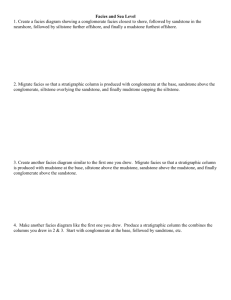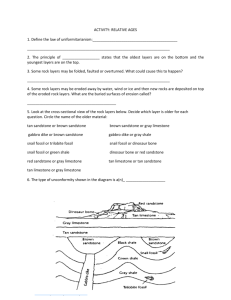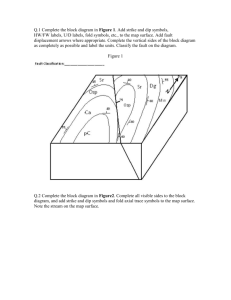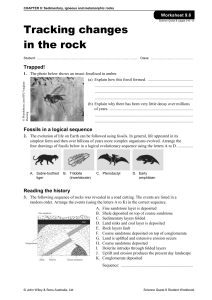Geologic Map of the Mesa del Yeso Quadrangle, Socorro County, New Mexico By
advertisement
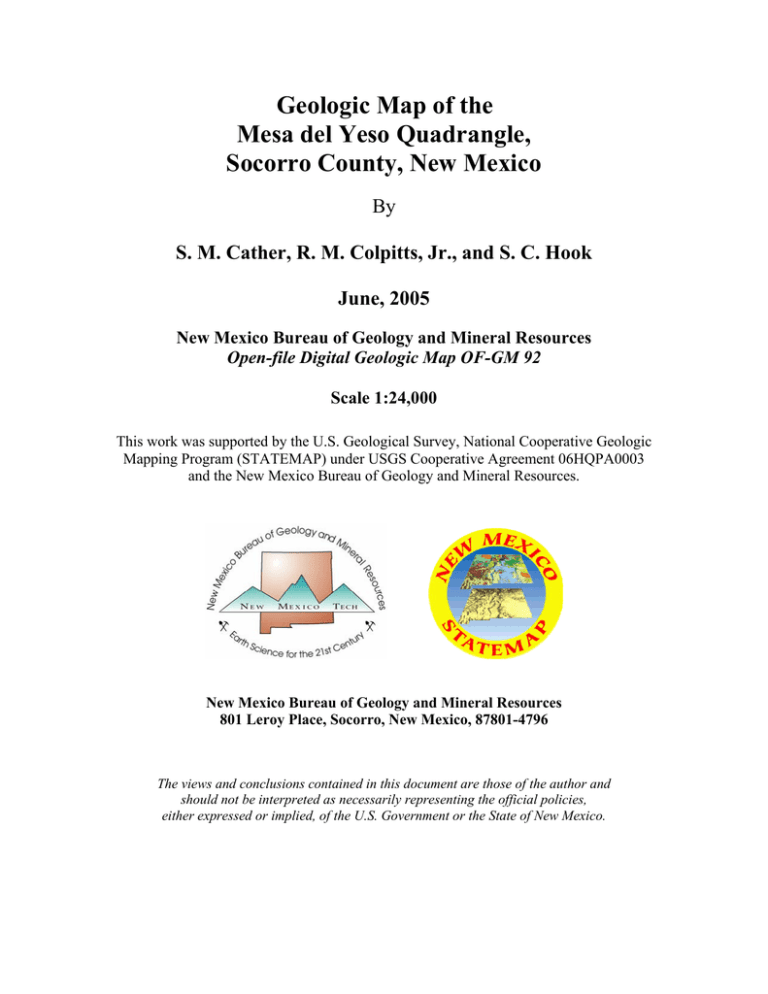
Geologic Map of the Mesa del Yeso Quadrangle, Socorro County, New Mexico By S. M. Cather, R. M. Colpitts, Jr., and S. C. Hook June, 2005 New Mexico Bureau of Geology and Mineral Resources Open-file Digital Geologic Map OF-GM 92 Scale 1:24,000 This work was supported by the U.S. Geological Survey, National Cooperative Geologic Mapping Program (STATEMAP) under USGS Cooperative Agreement 06HQPA0003 and the New Mexico Bureau of Geology and Mineral Resources. New Mexico Bureau of Geology and Mineral Resources 801 Leroy Place, Socorro, New Mexico, 87801-4796 The views and conclusions contained in this document are those of the author and should not be interpreted as necessarily representing the official policies, either expressed or implied, of the U.S. Government or the State of New Mexico. GEOLOGIC MAP OF THE MESA DEL YESO 7.5' QUADRANGLE, SOCORRO COUNTY, NEW MEXICO by S. M. Cather, R.M. Colpitts, Jr., and S.C. Hook OPEN-FILE DIGITAL GEOLOGIC MAP DGMDESCRIPTION OF UNITS CENOZOIC ERATHEM Middle Pleistocene-Holocene Qsg Sand and gravel (Holocene)––Sand, gravel, and minor mud in modern active arroyo channels and in the channel of the Rio Grande. 0–30 m thick Qal Alluvium (Holocene)––Sand, gravel, and mud adjacent to modern arroyo and river channels. Alluvium is typically at or near grade of modern channels, except in local areas where cutting of toes of piedmont slopes by the Rio Grande has caused arroyos to incise deeply (1–3 m). 0–30 m thick. Qf Mud and sand (Holocene)––Deposits on the modern floodplain of the Rio Grande. Qe Eolian deposits (upper Pleistocene-Holocene)––Eolian sands and loessic silts; deposits are stabilized by vegetation in most areas, but active dunes are present on lee sides of hills in some areas. Includes thin, discontinuous eolian veneers on stable upland surfaces that are intimately intertongued with alluvium. 0–10 m thick. Qpy Younger piedmont alluvium (upper Pleistocene)––Gravel, sand, and mud deposited at low elevations (less than about 30 m) above modern stream grade, east of the Rio Grande. Alluvium is representative of deposition in a variety of piedmont environments, including alluvial fans, paleovalley and arroyo fills, strath terraces, fill terraces, and pediments. At least two aggradational episodes are represented by Qpy. 0–25 m thick. Qpo Older piedmont alluvium (middle to lower(?) Pleistocene)––Gravel, sand, and mud deposited at higher elevations (more than about 30 m) above modern stream grade east of the Rio Grande. Range of depositional environments is similar to Qpy. At least two aggradational episodes are represented by Qpo. 0–40 m thick. SANTA FE GROUP Sierra Ladrones Formation (thickness unknown; lithofacies subdivisions after Cather, 1997) Pliocene to middle Pleistocene QTspc Conglomeratic piedmont facies––Characterized by conglomerate/sandstone ratio greater than 2/1. Conglomerate is typically poorly sorted and clast supported. Sandstone is typically medium to very coarse and crossbedded or horizontally stratified. Matrix-supported debris-flow deposits are common. Mudstone is rare. QTspc includes gravelly veneers on pediment surfaces. In addition to the subdivision of piedmont deposits based on textural criteria, these deposits were further subdivided on the basis of provenance. Siliciclastic piedmont deposits containing a dominance (>50%) of Mesozoic, Paleozoic, and Precambrian detritus are denoted by (s); dominantly volcaniclastic rocks are indicated by (v). Where they do not coincide with textural subdivisions, provenance contacts are denoted by a dot-dash symbol (see Explanation of Map Symbols). QTspcs Conglomerate-sandstone piedmont facies––Characterized by conglomerate/sandstone ratio between 2/1 and 1/2; this is the volumetrically dominant piedmont facies within the Sierra Ladrones Formation. Conglomerate is mostly clast-supported and poorly sorted. Sandstone is typically medium to very coarse-grained, commonly pebbly, and exhibits crossbedding or horizontal stratification. Mudstone is minor. Provenance subdivisions (v) and (s) are same as for QTspc. QTsps Sandstone-dominated piedmont facies––Characterized by conglomerate/ sandstone ratio of less than 1/2. Conglomerate is clast-supported and occurs in tabular or lenticular units <2 m thick. Sandstone is very fine to very coarse grained and exhibits a dominance of horizontal stratification. Mudstone is common and occurs as tabular units which locally compose as much as 20% of the unit. Calcareous paleosols are locally well-developed. Provenance subdivisions (v) and (s) are same as for QTspc. QTsa Axial-river facies––Channel and floodplain deposits of ancestral Rio Grande consisting of variable proportions of sandstone, mudstone, and conglomerate. Sandstone is typically crossbedded and poorly indurated. Clasts in conglomerate consist of well-rounded to sub-rounded pebbles of quartzite, chert, granite, gneiss, sandstone, volcanic lithics, siltstone, schist, phyllite, limestone, obsidian, and pumice. Mudstone ranges in color from reddish brown to greenish gray. Paleoflow was to the south. Crosses (x) on map indicate selected exposures of axial sandstone and conglomerate used to delineate areal extent of axial-river facies (QTsa) and transitional axial-piedmont facies (QTst). QTst Transitional axial-piedmont facies––Intertongued axial river deposits and piedmont deposits. Transitional deposits are defined as the zone of overlap between the basinward extent of piedmont sand and gravel and the mountainward extent of axial river sand and gravel. Mudstone is commonly ambiguous as to its former position within the facies tract (i.e. piedmont vs. axial), and thus is not a factor in delineating the transitional facies. QTsm Pond and lake deposits––Laminated reddish-brown mudstone and minor sandstone that accumulated in local ponds and lakes. POPOTOSA FORMATION Lower Miocene–upper Miocene Tppc Conglomeratic piedmont facies––Characterized by conglomerate/sandstone ratio of greater than 2/1. In this and other facies within the Popotosa Formation, detritus was derived dominantly from mid-Tertiary volcanic rocks. Conglomerate is mostly clast-supported, crudely imbricated, and poorly sorted. Sandstone in Tppc is medium to very coarse grained and commonly exhibits either crossbedding or horizontal laminations. Mudstone is rare, occurring mostly as thin, discontinuous drapes. Oligocene (40Ar/39Ar ages are from McIntosh et al., 1991) Tsc South Canyon Tuff––Light gray to light purple, densely welded, crystal-poor to moderately crystal-rich rhyolite ignimbrite. Crystals are mostly sanidine and quartz; lithic fragments are common. At least 375 m thick. 40Ar/39Ar age is 27.4 Ma. Corresponds to Units Tpc1 and Tpc2 of Spradlin (1976). Tlp La Jara Peak Basaltic Andesite––Aphanitic to slightly porphyritic mafic flows and associated breccias of mostly basaltic andesite composition. Phenocrysts are mostly plagioclase and clinopyroxene. In the quadrangle, the unit occurs as six tongues: (1) within the upper Spears Group, (2) below the Hells Mesa Tuff, (3) below the La Jencia Tuff, (4) below the Vicks Peak Tuff, (5) below the Lemitar Tuff, (6) below the South Canyon Tuff (note that this stratigraphic distribution is greater than originally defined by Osburn and Chapin, 1983). Composite thickness is many hundreds of meters. Age range is ~36-24 Ma in the quadrangle. Corresponds to units Tsp-a1, Tsp-a2, Thm-a, Taw-a, and Trdc-a of Spradlin (1976). Tl Lemitar Tuff––Pink, densely welded, moderately crystal-rich rhyolite ignimbrite. Crystals are sanidine, plagioclase, quartz, and biotite; lithics are minor. Thickness is about 75 m. 40Ar/39Ar age is 28.0 Ma. Corresponds to unit Taw of Spradlin (1976). Tvp Vicks Peak Tuff––Light gray, moderately welded, crystal-poor rhyolite ignimbrite. Thickness is about 100 m. 40Ar/39Ar age is 28.6 Ma. Corresponds to unit Talp4 of Spradlin (1976). Tlj La Jencia Tuff––Pink to gray, densely to moderately welded, crystal-poor, rhyolitic ignimbrite that exhibits compound cooling. Upper part of unit is prominently flow-banded. Crystals are mostly sanidine and quartz; lithics are typically sparse. Thickness is about 315 m. 40Ar/39Ar age is 28.9 Ma. Corresponds with units Talp1, Talp2, Talp3a, Talp3, and Talp-af of Spradlin (1976). Tzt Luis Lopez Formation––Crystal-poor, moderately to poorly welded, pumiceous rhyolitic ignimbrite. Rare crystals include sanidine, plagioclase, and quartz; lithics are locally sparse to abundant. Exposed only in north-central part of quadrangle. 0–60 m thick. Corresponds to unit Tscp of Beck (1993). Thm Hells Mesa Tuff––Brownish pink, crystal-rich, densely welded rhyolitic ignimbrite. Crystals are sanidine, quartz, and biotite; lithics are sparse. Thickness ranges from 150-300 m. 40Ar/39Ar age is 32.1 Ma. Corresponds to units Thm1 and Thm2 of Spradlin (1976). Tsu Upper Spears Group––Dark- to medium-gray volcaniclastic sandstone, conglomerate, and minor mudstone. Debris-flow breccias are locally present. Clast lithotypes are mostly dark gray basaltic andesite (plagioclase- and clinopyroxene-bearing) but also andesite-dacite (plagioclase- and amphibolebearing). 0–80 m thick. Age range ~36–32 Ma (Cather et al., 1987). Spears Group terminology used as defined by Cather et al. (1994). Tsl Lower Spears Group––Medium- to light-gray volcaniclastic sandstone, conglomerate, debris-flow breccia, and minor mudstone. Clasts are dominated by plagioclase- and amphibole-bearing andesite and dacite. Minor amounts of nonvolcanic clasts are locally present above transition with underlying Baca Formation. Thickness is ~300–500 m. Age range is ~39–36 Ma (Cather et al., 1987). Usage of the term Datil Group is after Cather et al. (1994). Eocene Tb Baca Formation (middle Eocene)––Fluvial red-bed sandstone, conglomerate, and mudstone. Sandstone is commonly cross-bedded; conglomerate contains pebbles, cobbles and boulders of Cretaceous, Paleozoic, and Proterozoic lithotypes. Sedimentary-clast dominated facies (Tbps) was derived from the south (Parida structural zone) and from the west (Sierra uplift of Cather, 1983). Granitegneiss dominated facies (Tbpg) was derived from basement exposures to the west (Sierra uplift) and to the east (southern Montosa uplift of Cather, 1992). Sandstone and conglomerate containing clasts of well-rounded quartzite and metavolcanics (Tbae) that resemble clasts present in the Mogollon Rim and Eagar Formations of eastern Arizona and western New Mexico represent exotic axialriver deposits derived from far to the west in the Mogollon highland. Tongues of sandstone and conglomerate that contain more than 10% volcanic detritus (Tbpv) occur in the middle and upper Baca Formation. These deposits were derived from the west and mark the transition to the overlying Spears Group. MESOZOIC ERATHEM Upper Cretaceous Kcc Crevasse Canyon Formation (Coniacian-Santonian?)––Non-marine and minor brackish-water sandstone, shale, and coal-bearing unit that has a sharp basal contact and an erosional upper contact. Thickness is indeterminate due to erosion, but could exceed 300 m. Numerous, isolated outcrops with no basal contacts occur along the valley floor in the northeast portion of quadrangle. About 2 km northeast of Puertecito of Bowling Green, lenses of pebble conglomerate occur in the uppermost Crevasse Canyon Formation. These conglomerates were derived from the southwest and consist mostly of quartzite and chert pebbles recycled from Mesozoic strata, but also contain sparse pebbles of Paleozoic limestone. These relationships indicate the nearby Sierra uplift was being unroofed late in Crevasse Canyon time. Crassostrea soleniscus (Meek) occurs in brackish water coquinas in many of these exposures. (Crassostrea soleniscus (Meek) and Ostrea elegantula White occur in separate coquinas in a 1–2 m sandstone bed that is ~30 m above the Gallup and 10 m above the coal on the Becker SW 7.5' quadrangle. See Darton (1928, p.75) and Baker (1981, p. 48) for details.) Kg Gallup Sandstone (Lower Coniacian)––Fine grained, marine, regressive, coastal barrier sandstone unit that is 4–10 m thick. Thickest sections are gray to yellowish gray, poorly indurated, slope-forming units; thinner sections are more induratedoften concretionary and fossiliferous- sandstones that form ledges. Lower contact is gradational; upper is fairly sharp. Concretionary sandstones have yielded abundant Ostrea elegantula White and Pleuriocardia (Dochmocardia) curtum (Meek and Hayden). Cremnoceramus erectus (Meek) was collected about 1.5 km north of the quadrangle. Kmd D-Cross Tongue of the Mancos Shale (Upper Middle Turonian–Lower Coniacian)––Noncalcareous, medium gray, marine shale unit that contains two thin calarenites 3–6 m above the Tres Hermanos Fm., a medial 1.5 m thick sandstone, and fossiliferous concretions. This 105–115 m thick, slope-forming unit has a sharp basal contact and a gradational upper contact. Fossils from the basal calcarenites include Prioncyclus wyomingensis (Meek) and Scaphites warreni Meek and Hayden; concretions have yielded Prioncyclus novimexicanus (Marcou); the medial sandstone has Forresteria sp., Lopha sannionis (White), and sparse Ostrea elegantula White Kth Tres Hermanos Formation (Middle Turonian)––Sandstone and shale unit that forms a regressive-transgressive wedge of nearshore marine and non-marine deposits that is 76-82 m thick with a gradational base and a sharp top. Consists of three members, in descending order: Fite Ranch Sandstone Member (Kthf) (upper Middle Turonian)––Highly bioturbated, coastal barrier sandstone that coarsens upward from very fine grained to lower fine grained. Sandstones are light gray, but weather light to dark brown and constitute a 10–13 m thick ridge-forming unit with sharp top and gradational base. Contains Lopha bellaplicata novamexicanum Kauffman. Carthage Member (Kthc) (middle Middle Turonian)––Marine, marginal marine, and non-marine sandstone and shale slope-forming unit 58–64 m thick; lower two-thirds contains thin, fine grained sandstone beds of paludallacustrine or crevasse splay origin and discontinuous, cross-bedded channel sandstones. Upper third contains marine shale with fossiliferous concretions and Prionocyclus hyatti (Stanton). Atarque Sandstone Member (Ktha) (lower Middle Turonian)––Regressive coastal barrier sandstones that weather light gray to dark brown or buff. Lower sandstones are transitional with underlying shale and constitute a 5–7 m thick, ridge-forming unit that has very fossiliferous lenses and concretionary sandstone bodies with Pleuriocardia (Dochmocardia) pauperculum (Meek) and Gyrodes spp. Uppermost bed is commonly a brackish water coquina of Crassostrea soleniscus (Meek). Kml Lower part of the Mancos Shale (Middle Cenomanian-Lower Turonian)–– Calcareous and noncalcareous, gray, marine, slope-forming shale with minor, thin sandstone beds near base and top. Sharp basal contact and gradational upper contact. The only exposure is in the NE part of the quadrangle, where the top is faulted. Contains numerous thin bentonite beds. Calcareous shale in upper part of unit weathers to a lighter gray and contains abundant Pycnodonte newberryi (Stanton). Thin sandstones in basal 15 m contain common Ostrea beloiti Logan. Baker (1981, p. 16) reports Conlinoceras tarrantense (Adkins) (as Calycoceras gilberti Cobban and Scott) from 25 cm above base. Kd Dakota Sandstone (Middle Cenomanian)––Baker (1981, p. 13) reported 15.5 m of sandstone and shale in NE part of the quadrangle. The upper sandstone is a ridge-forming, bioturbated, gray, fine grained sandstone that weathers brown, and is 8.5 m thick. The lower sandstone, 2 m thick with pebbly lenses, is separated form the upper by 5.2 m of medium gray, silty shale. No body fossils have been found in the Dakota. Jurassic Jm Morrison Formation (Upper Jurassic)––Light gray to light brown crossbedded sandstone and minor siltstone 0–15 m thick. Fills paleovalley about 300 m wide that is cut into Chinle Group in the northeast part of the quadrangle. Probably is correlative with the Saltwash Member. Triassic TRc Chinle Group (Upper Triassic)––Red, gray and maroon fluvial mudstone with subordinate sandstone,limestone-pebble conglomerate,and limestone. Forms slopes and valleys. About 200 m thick. TRm Moenkopi Formation (Middle and Lower Triassic)––Red-brown, brown, and buff continental mudstone, sandstone and minor conglomerate. 0–30 m thick. PALEOZOIC ERATHEM Permian Pag Artesia Formation (Permian, Guadalupian? to Ochoan?)––Interbedded moderate red (5R 4/6) to pale reddish-brown (10R 5/4) and very pale orange (10YR 8/2), calcareous and occasionally gypsiferous siltstones, and very fine to fine-grained quartz, calcareous and slightly micaceous sandstones, with are dark reddish-brown (10R 3/4) to light olive-gray (5Y 6/1), slightly micaceous mudstones, which have scattered halite casts and are broadly lenticular. Thickness: 0–30 meters. Psa San Andres Formation (Permian, Leonardian)––Interbedded limestone, dolostone, breccia and gypsum. Limestones are brownish-black (5YR 2/1), pale yellowish-brown (10YR 6/2) and medium gray (N5) and range from wackestone to grainstone. Dolostones are brownish-gray (5YR 4/1) to olive-gray (5Y 4/1), and locally gypsiferous. Breccias consist of brownish-black (5YR 2/1) limestone and dolostone breccias that grade laterally into thin-bedded, dark gray (N3) limestones. The gypsums are white (N9) to light gray (N7), laminated and poorly exposed. The gypsum is absent across the southern and western parts of the map but is as much as 122 meters thick in the northeastern part of the map. Thickness: 60–200 meters. Pg Glorieta Sandstone (Permian)––White (N9) to very pale orange (10YR 8/2), fine- to medium-grained, friable to well-indurated, crossbedded quartz arenite (Plate 12). Has scattered coarse-grained, well-rounded, frosted quartz grains, especially in the lower half of the unit. Thickness: 55–63 meters. Py Yeso Formation (Permian, Leonardian)––Interbedded sandstone, siltstone, dolomitic limestone and shale. Divided into four members (in ascending order): Meseta Blanca, Torres, Cañas Gypsum, and Joyita Members. The Meseta Blanca Member constitutes the lower Yeso Formation (Pyl) and the Torres, Cañas Gypsum and Joyita Members constitute the upper Yeso Formation (Pyu). Meseta Blanca Mbr: Interbedded very pale orange (10YR 8/1), pinkish-gray (5YR 8/1) and moderate reddish-brown (10R 4/6), very fine- to coarse-grained quartz sandstone, are very light gray (N8) to dark reddish-brown (10R 3/4) siltstone and are dark reddish-brown (10R 3/4) to grayish-red (5R 4/2) slope forming mudstones and shales. Thickness: 90 meters. Torres Mbr: interbedded pale to moderate reddish-brown (10R 5/4 to 10R 4/6), grayish-pink (5R 8/2) or grayishred (5R 4/2), fine- to medium-grained quartz sandstone, white (N9) to light gray (N7) gypsum thin layers and lenses of dolomitized oolitic limestone, and pale yellowish-brown (10YR 6/2) to olive black (5Y 2/1) limestones that ranges from carbonate mudstone to peloidal or oolitic packstones and grainstones and are locally fossiliferous, dolomitic, and argillaceous. As many as 12 limestone beds present within the section. Thickness: 173 meters. Cañas Gypsum Mbr: interbedded very light gray to white (N8 to N9) laminated to chicken-wire gypsum and minor, thin very fine-grained silty sandstone and a thin, medial, fetid, gypsiferous carbonate mudstone. Thickness: 0–24 meters. Joyita Mbr: Pale reddish-brown (10R 5/4) to moderate reddish-orange (10R 6/6), friable and calcareous, fine- to very fine-grained quartz sandstones with scattered displacive halite casts and clay flakes on bedding surfaces. The upper beds display low-angle cross beds and ripple cross-laminations. Thickness: 29–36 meters. Pa Abo Formation (Permian, Leonardian)––Interbedded dark reddish brown (10R 3/4) mudstone and shale, and grayish red (10R 4/2) to dark reddish brown (10 R 3/4) siltstone, sandstone and, locally, thin conglomerate and rare limestone. Thickness: 685 feet (209 meters). Pb Bursum Formation (Permian, Wolfcampian)––Interbedded medium dark gray (N4) to brownish gray (5YR 4/1) with some grayish red (5R 4/2) shale, medium gray (N5) to brownish black (5YR 2/1), peloidal and fossiliferous locally dolomitic limestone, and grayish orange pink (10R 8/2) to grayish orange (10YR 7/4), fine to very coarse-grained, very lenticular and trough cross-bedded sandstones. About 200 m thick. Pennsylvanian IPm Madera Group (Pennsylvanian, Desmoinsian to Virgilian)––Interbedded medium to dark gray (N3 to N5) marine limestones, dark gray (N3) to moderate reddish brown (10R 4/6) shale and siltstone, and marginal marine sandstone and conglomerate. At least 200 m thick. EXPLANATION OF MAP SYMBOLS Contact between geologic units, or between textural lithofacies of Santa Fe Group. Dashed where approximately located. Dotted where concealed (Santa Fe Group lithofacies only). Dash-dot symbol divides petrofacies (sedimentary versus volcanic provenance) in the Santa Fe Group where boundaries do not coincide with lithofacies boundaries. Fault showing direction and dip of fault plane. Dashed where approximately located; dotted where concealed. Bar and ball on downthrown block of steep faults. Square teeth on upper plate of moderate- to low-angle fault that parallels bedding or cuts out section (younger over older); triangular teeth on upper plate of low-angle fault that repeats section (older over younger). Anticline showing trace of axial plane and plunge direction. Dashed where approximately located, dotted where concealed. Syncline showing trace of axial plane and plunge direction. Dashed where approximately located, dotted where concealed. Strike and dip of bedding. Vertical bedding. Horizontal bedding. Selected exposure of axial sand or gravel in Sierra Ladrones Formation used to delineate areal extent of QTsa or QTst. Paleocurrent direction based on pebble imbrication or crossbedding. Paleocurrent direction in axial river deposit of Santa Fe Group based on pebble imbrication or crossbedding. REFERENCES Baker, B. W., 1981, Geology and depositional environments of Upper Cretaceous rocks, Sevilleta Grant, Socorro County, New Mexico [Masters thesis]: Socorro, New Mexico Institute of Mining and Technology: 159 p. Beck, W. C., 1993, Structural evolution of the Joyita Hills, Socorro County, New Mexico [Ph.D. dissertation]: Socorro, New Mexico Institute of Mining and Technology: 187 p. Cather, S. M., 1983, Laramide Sierra uplift: Evidence for major pre-rift uplift in central and southern New Mexico: New Mexico Geological Society, Guidebook 34: 99– 101. Cather, S. M., McIntosh, W. C. et al., 1987, Stratigraphy, age, and rates of deposition of the Datil Group (upper Eocene-lower Oligocene), west-central New Mexico: New Mexico Geology, vol. 9: p. 50–54. Cather, S. M., and McIntosh, W. C., 1994, The Plio–Pleistocene Quemado Formation of west-central New Mexico: New Mexico Geological Society, Guidebook 45, p. 279–281. Cather, S. M., 1997, Toward a hydrogeologic classification of map units in the Santa Fe Group, Rio Grande rift, New Mexico: New Mexico Geology, v. 19, no. 1, p. 15– 21. Darton, N. H.,1928, “Red beds” and associated formations in New Mexico: U.S. Geological Survey Bulletin, v. 55, p. 550–565. Spradlin, E. J., 1976, Stratigraphy of Tertiary volcanic rocks, Joyita Hills area, Socorro County, New Mexico [M.S. thesis]: Albuquerque, University of New Mexico, 73 p.



